
A bicycle, also called a bike or cycle, is a human-powered or motor-powered, pedal-driven, single-track vehicle, having two wheels attached to a frame, one behind the other. A bicycle rider is called a cyclist, or bicyclist.
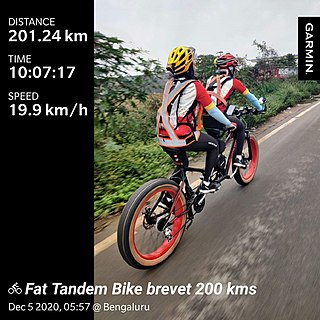
The tandem bicycle or twin is a form of bicycle designed to be ridden by more than one person. The term tandem refers to the seating arrangement, not the number of riders. Patents related to tandem bicycles date from the mid 1880s. Tandems can reach higher speeds than the same riders on single bicycles, and tandem bicycle racing exists. As with bicycles for single riders, there are many variations that have been developed over the years.

A recumbent bicycle is a bicycle that places the rider in a laid-back reclining position. Most recumbent riders choose this type of design for ergonomic reasons: the rider's weight is distributed comfortably over a larger area, supported by back and buttocks. On a traditional upright bicycle, the body weight rests entirely on a small portion of the sitting bones, the feet, and the hands.
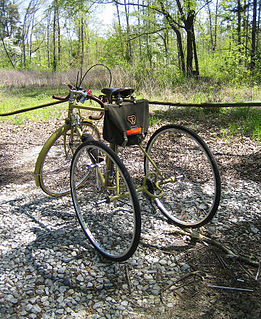
A tricycle, often abbreviated to trike, is a human-powered three-wheeled vehicle.

A velomobile, velomobiel, velo, or bicycle car is a human-powered vehicle (HPV) enclosed for aerodynamic advantage and/or protection from weather and collisions. They are similar to recumbent bicycles, pedal go-karts and tricycles, but with a full fairing. A fairing may be added to a non-faired cycle, or the fairing may be an integral part of the structure, monocoque like that of an airplane. The term velomobile can be thought of as similar in scope to the cycle world as the term automobile is to the automotive world.

Freight bicycles, carrier cycles, freight tricycles, cargo bikes, box bikes, or cycletrucks are human powered vehicles designed and constructed specifically for transporting loads. Vehicle designs include a cargo area consisting of an open or enclosed box, a flat platform, or a wire basket, usually mounted over one or both wheels, low behind the front wheel, or between parallel wheels at either the front or rear of the vehicle. The frame and drivetrain must be constructed to handle loads larger than those on an ordinary bicycle.
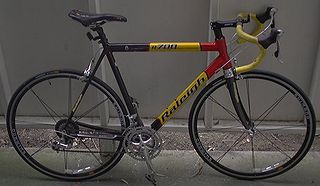
A racing bicycle, also known as a road bike, and once popularly known as a ten speed, is a bicycle designed for competitive road cycling, a sport governed by and according to the rules of the Union Cycliste Internationale (UCI). The UCI rules were altered in 1934 to exclude recumbent bicycles.

A sprocket, sprocket-wheel or chainwheel is a profiled wheel with teeth, or cogs, that mesh with a chain, track or other perforated or indented material. The name 'sprocket' applies generally to any wheel upon which radial projections engage a chain passing over it. It is distinguished from a gear in that sprockets are never meshed together directly, and differs from a pulley in that sprockets have teeth and pulleys are smooth except for timing pulleys used with toothed belts.

Vehicles for human transport that have two wheels and require balancing by the rider date back to the early 19th century. The first means of transport making use of two wheels arranged consecutively, and thus the archetype of the bicycle, was the German draisine dating back to 1817. The term bicycle was coined in France in the 1860s, and the descriptive title "penny farthing", used to describe an "ordinary bicycle", is a 19th-century term.
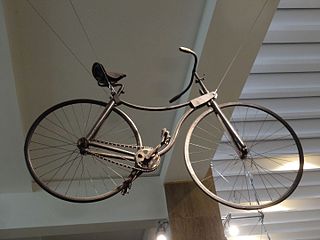
A safety bicycle is a type of bicycle that became very popular beginning in the late 1880s as an alternative to the penny-farthing ("ordinary") and is now the most common type of bicycle. Early bicycles of this style were known as safety bicycles because they were noted for, and marketed as, being safer than the high wheelers they were replacing. Even though modern bicycles use a similar design, the term is rarely used today and is considered obsolete outside circles familiar with high wheelers.
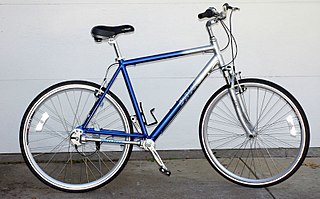
A shaft-driven bicycle is a bicycle that uses a drive shaft instead of a chain to transmit power from the pedals to the wheel. Shaft drives were introduced over a century ago, but were mostly supplanted by chain-driven bicycles due to the gear ranges possible with sprockets and derailleurs. Recently, due to advancements in internal gear technology, a small number of modern shaft-driven bicycles have been introduced.

A motorized bicycle is a bicycle with an attached motor or engine and transmission used either to power the vehicle unassisted, or to assist with pedalling. Since it always retains both pedals and a discrete connected drive for rider-powered propulsion, the motorized bicycle is in technical terms a true bicycle, albeit a power-assisted one. However, for purposes of governmental licensing and registration requirements, the type may be legally defined as a motor vehicle, motorbike, moped, or a separate class of hybrid vehicle.
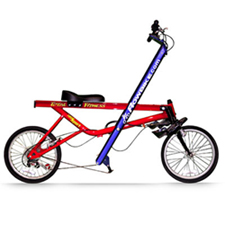
A rowbike is an example of a rowing cycle, hybrid fitness/transport machine that combines a bicycle, and a rowing machine. "Rowbike" is a trademark of the Rowbike company. The Rowbike was invented by Scott Olson, the creator of Rollerblade inline skates. "Rowling" is a combination of rowing and rolling and is sometimes used in place of rowing when describing a Rowbike.

A handcycle is a type of human-powered land vehicle powered by the arms rather than the legs, as on a bicycle. Most handcycles are tricycle in form, with two coasting rear wheels and one steerable powered front wheel. Despite usually having three wheels, they are also known as handbikes.

A balance bicycle or run bike or no pedal bike or dandy horse is a training bicycle that helps children learn balance and steering. It has no foot pedals, no drivetrain, no chain, no gears, no gear shifters, no derailleurs, and no freewheel.

A quadracycle is a four-wheeled human-powered land vehicle. It is also referred to as a quadricycle, quadcycle, pedal car or four-wheeled bicycle amongst other terms.

The following outline is provided as an overview of and topical guide to bicycles:

Bicycle drivetrain systems are used to transmit power on bicycles, tricycles, quadracycles, unicycles, or other human-powered vehicles from the riders to the drive wheels. Most also include some type of a mechanism to convert speed and torque via gear ratios.



















